Freeze-dried food has come a long way since the days of bland, tasteless mush. Nowadays, freeze-dried meals combine the flavors of home cooking with the convenience of instant preparation. Freeze drying removes the water from fresh foods, making them lightweight and shelf-stable while preserving the flavor, nutrients, and original texture. All that is needed to rehydrate is water, vastly reducing the gear backpackers need to carry. Beyond just convenience, they provide essential nutrients to keep your energy up while exploring.
This guide aims to give you the information you need to choose the best freeze-dried meals for your hike. Many companies are now making food for backpackers, but we have picked out the most highly rated options that really deliver on taste and nutrition.
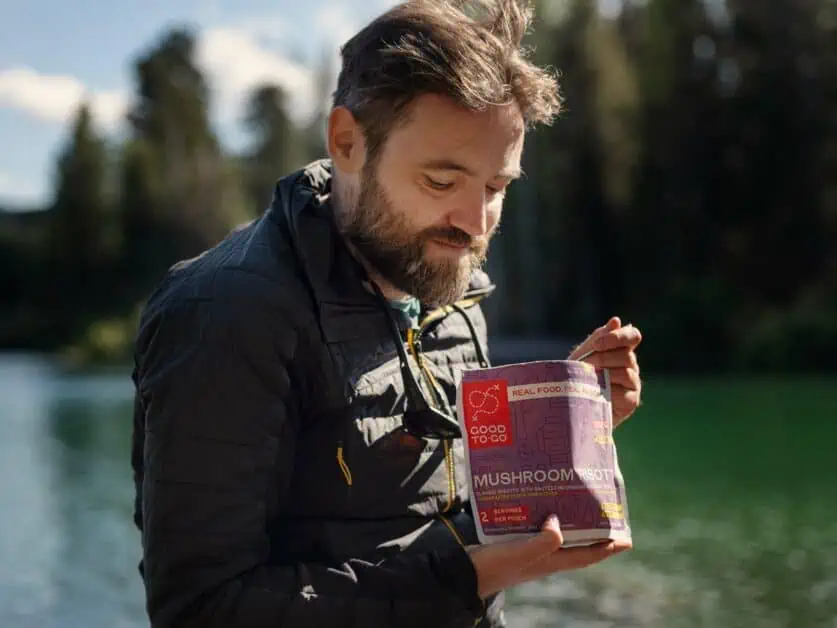
Editor’s Note: This article is part of our overall guide to camping and backpacking food and nutrition. Check out our other guides:
What to Look for When Choosing Freeze Dried Meals
With so many freeze-dried meal varieties available, it can get confusing trying to decide which one would be best for you. There are some things you need to consider when looking at your options:
Energy-to-Weight Ratio
How many calories you will get per every ounce you carry is a vital consideration. When you are backpacking, you will have limited space and weight capacity, but you will also need high-energy food to fuel your hiking. By prioritizing meals with a high energy-to-weight ratio, you will carry less weight while ensuring you get the necessary calories. A freeze-dried meal that’s lightweight but packed with energy is ideal, so you can trek for longer and recover faster without being weighed down by your food supply. To help, we have provided the weight of the meal packets as well as the calories in each serving.
Nutrition
Carbohydrates are the best energy source when hiking and backpacking because they are easier for your body to process than fats or protein. This means they’re less likely to put you at risk of an upset stomach. Research suggests you should eat 30 to 60 grams of carbohydrates per hour when backpacking.
Calories are also vital when you are backpacking. The caloric needs when backpacking vary based on factors like individual metabolism, pack weight, terrain, and hiking intensity. On average, backpackers burn between 3,000 to 6,000 calories per day. A strenuous day with a heavy rucksack and challenging terrain can lean towards the higher end, while lighter days fall on the lower side. It’s crucial for backpackers to adequately replenish these calories to maintain energy, strength, and overall health during their expedition.
Protein is essential for backpackers due to its role in muscle repair and recovery after the physical exertion of hiking. It helps maintain muscle mass, supports immune function, and provides a sustained energy source. Ensuring sufficient protein intake prevents muscle breakdown, aids in tissue repair, and helps keep energy levels steady during extended hikes.
Cost
Freeze-dried meals are not cheap! When considering the cost of the convenience they offer, there are a few factors that help freeze-dried meals seem less expensive.
- The majority of freeze-dried meals only need water added to them to give you a meal that will meet all your nutritional needs. This means you have no added expenses for ingredients and equipment.
- It is worth checking how much water the instructions state. The less water required, the less fuel you will use to boil the water, reducing your costs.
- When buying freeze-dried meals, you can usually find deals that reduce the price if you buy in bulk.
- These meals typically have a long shelf life, so you don’t need to worry about throwing them away when they go past their use-by date. Many manufacturers say their freeze-dried foods can be used even after the specified date as they are safe to eat but may be less flavourful.
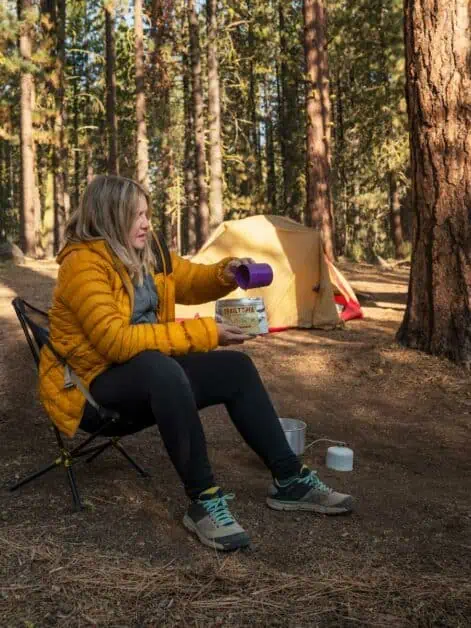
Tips For Making Freeze-Dried Meals in Camp
If you have never used freeze-dried meals before, you may not be sure what to expect. Here are our top tips to make your meals a success:
Water Temperature
Freeze-dried meals usually rehydrate best with boiling water. Depending on where you are camping, you may need to make adjustments when heating your water. At higher altitudes, atmospheric pressure decreases, causing water to boil at a lower temperature. For instance, while water boils at 100°C (212°F) at sea level, it might boil at around 93°C (200°F) at 2,500 meters (8,200 feet). To compensate for this, don’t put all the water in straightaway when making your freeze-dried meals at a high altitude and leave it to rehydrate for longer than instructed. You can always add more water, but if you put too much in, you can end up with a gloopy, soupy meal.
Long Fork or Spoon
The pouches that most freeze-dried meals come in are designed to be eaten out of. This is great as it means you don’t need a plate or bowl, but most pouches are deeper than an average eating utensil handle. It is worth investing in a long-handled spoon for eating your meals. A spoon is generally better than a fork as there is usually some kind of sauce, but you could always use a spork for the best of both worlds.
Seasoning
Everyone has different tastes, but the main complaint about freeze-dried meals is the lack of seasoning. Carrying salt and pepper with you means you can add a little if needed. If you like your meals with a spicy kick, you could add chili flakes to increase the heat. You can buy little containers designed for carrying herbs and spices in your backpack, or you could improvise containers yourself. Creating a packet from folded foil can work well as it doesn’t easily tear when opening and closing it.
Oxygen Absorber
When you open your pouch of freeze-dried food, you will probably see a packet labeled ‘oxygen absorber’ that you must remove before adding the water. Freeze-dried meals contain oxygen absorbers to remove residual oxygen from the packaging. Oxygen can degrade food quality by causing oxidation, which leads to spoilage and the loss of nutritional value. Additionally, oxygen allows certain microorganisms to thrive, potentially resulting in food spoilage. By absorbing the oxygen, these packets help prolong the shelf life of freeze-dried meals, ensuring they remain fresh, nutritious, and safe to eat for extended periods. If you forget to take it out, don’t worry, just eat around it!
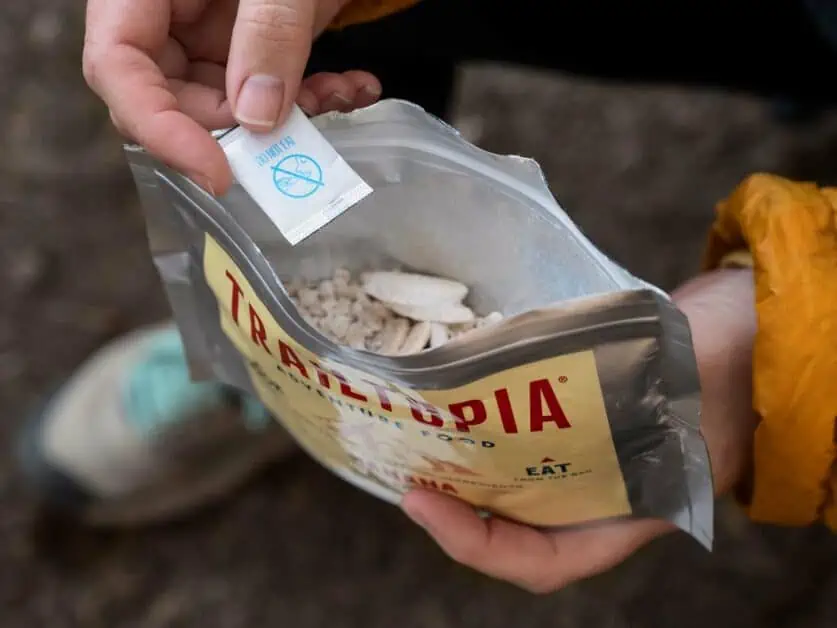
Insulate
One of the great things about freeze-dried meals is that they provide a hot meal at the end of your day’s hike. However, they usually have to rehydrate for ten or more minutes. Depending on the climate where you are camping, this can result in your food being lukewarm. To prevent this, providing some insulation around the pouch is a good idea. You can buy insulation pouches designed for this purpose or wrap a sweater or towel around the meal. The packets that freeze-dried meals come in usually reseal after the water is added, but it is still a good idea to prop them upright just to be sure.
The Best Freeze Dried Meals
Recommending food is a tricky task as one person’s delicious meal can taste disgusting to the next person. We have made sure that every one we have chosen is among the best-selling and top-reviewed available and tried to give you an idea of what they taste like. We have also provided the important nutrition information and weight so you can make an informed choice.
Breakfast
Breakfast is often described as the most important meal of the day, and this is especially true when you are backpacking. Freeze-dried breakfast meals are ideal as there is minimal clean-up meaning you can get on the trail as soon as possible. The breakfast meals are mainly a choice of granola or oatmeal with freeze-dried fruit, eggs with meat and some vegetables, or biscuits and gravy. Granola is the quickest to make and can usually be made with hot or cold water.
Mountain House Granola with Milk & Blueberries
Sweet granola with blueberries is added to milk in this breakfast. The milk turns purple which is always fun. It can be made with hot or cold water or even eaten dry as a snack. It is sweet, and if, like me, you don’t like vanilla, this might not be for you.
Servings:
2 servings per pouch. Also available in single servings (Military) and bulk 20 servings tin
Weight:
4 ounces
Rehydration Time:
9 minutes
Calories:
260 per serving, 520 per pouch
Carbohydrates:
37g per serving, 74g per pouch
Protein:
8g per serving, 15g per pouch
Backpacker's Pantry Peanut Butter Banana Oatmeal
This has rolled oats with small chunks of banana, sugar and cinnamon, and peanut butter in a separate pouch to add at the end. It’s quick to make, but you might need to give it an extra stir and leave it a few minutes longer. What’s also great is that it’s naturally vegan and gluten free.
Servings:
1 serving per pouch, 6 packs available
Weight:
4.3 ounces
Rehydration Time:
5 minutes
Calories:
520 per serving/pouch
Carbohydrates:
36g per serving/pouch
Protein:
16g per serving/pouch
AlpineAire Foods Strawberry Granola with Milk
This sweet granola has strawberries, milk, honey, and vanilla. It can be made with hot or cold water, and it is a personal choice how long you leave it to rehydrate, but it will probably need at least five minutes.
Servings:
1 serving per pouch
Weight:
6.5 ounces
Rehydration Time:
5 minutes
Calories:
820 per serving/pouch
Carbohydrates:
108g per serving/pouch
Protein:
19g per serving/pouch
Peak Refuel Mountain Berry Granola
This meal has chunks of granola with strawberries, blueberries, and raspberries in rice milk. What’s great is it’s vegan suitable. It is excellent if you are lactose intolerant too and even if you’re used to drinking milk, you won’t notice the difference. It can be made with hot or cold water, and you get a lot of fruit.
Servings:
2 servings per pouch
Weight:
5.07 ounces
Rehydration Time:
5 minutes
Calories:
280 per serving, 570 per pouch
Carbohydrates:
54g per serving, 108g per pouch
Protein:
7g per serving, 13g per pouch
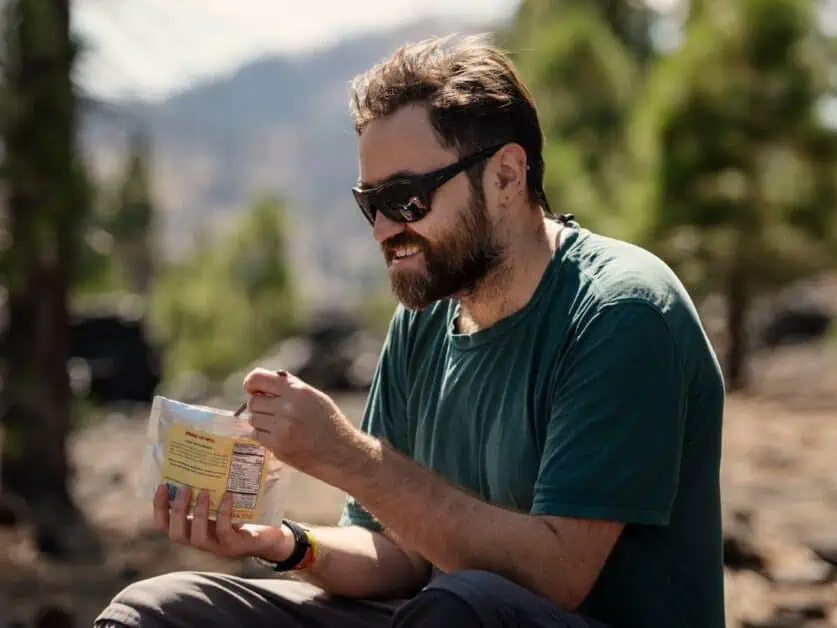
Mountain House Breakfast Skillet
This meal is as close as you can get to a cooked breakfast while camping. Scrambled eggs with nuggets of pork and shredded potato are seasoned with onion, bell pepper, a little garlic, and white pepper. It’s also gluten free.
Servings:
2 servings per pouch. Also available in single servings (Pro-Pak) and bulk 8 servings tin
Weight:
3.7 ounces
Rehydration Time:
9 minutes
Calories:
260 per serving, 510 per pouch
Carbohydrates:
23g per serving, 46g per pouch
Protein:
14g per serving, 28g per pouch
Peak Refuel Breakfast Skillet
Scrambled eggs are the basis of this breakfast, with bits of pork sausage, potato cubes, and big strips of green and red bell peppers, onion, and black pepper. This meal really divides people; some say it is the best they have ever tasted, and others find it watery and bland. However, everyone agrees that you get large portions. It has a longer than usual soaking time, so make sure you leave it rehydrating the full amount of time.
Servings:
2 servings per pouch
Weight:
6.8 ounces
Rehydration Time:
15 minutes
Calories:
340 per serving, 680 per pouch
Carbohydrates:
23g per serving, 45g per pouch
Protein:
19g per serving, 39g per pouch
Peak Refuel Biscuits & Sausage Gravy
This breakfast gives you two buttermilk biscuits and little bits of pork sausage in a creamy gravy seasoned with black pepper. Some people like to leave the two biscuits whole, so they are crunchy, but most break them up into smaller bits, so they rehydrate better. If you’re not making them smaller, you might need to experiment with a little more water or a longer rehydration time.
Servings:
2 servings per pouch
Weight:
6.8 ounces
Rehydration Time:
10 minutes
Calories:
570 per serving, 1100 per pouch
Carbohydrates:
27g per serving, 51g per pouch
Protein:
18g per serving, 34g per pouch
Mountain House Biscuits & Gravy
Small pieces of buttermilk biscuits and little bits of pork in a creamy, peppery gravy seasoned with pepper, ginger, and lots of herbs. It doesn’t look great, but the taste outweighs that and it’s a firm favorite.
Servings:
2 servings per pouch. Also available in bulk 12 servings tin
Weight:
4.4 ounces
Rehydration Time:
9 minutes
Calories:
280 per serving, 560 per pouch
Carbohydrates:
37g per serving, 73g per pouch
Protein:
11g per serving, 22g per pouch
Main Meal
Most backpackers will eat their main meal in the evening when they have finished walking. Research has shown that there is a 30-to-45-minute window after you stop hiking when your muscles will recover more efficiently. You need plenty of carbohydrates for energy and lots of protein for muscle repair. The recommendation is a 4:1 ratio of complex carbohydrates to protein. Freeze-dried meals are a good option as they can be made and eaten quickly.
Peak Refuel Chicken Coconut Curry
Chunks of carrot and chicken in a coconut curry sauce with rice. This is a Thai curry with lemongrass, galangal, coriander root, and kaffir lime peel. It’s not very spicy, so if you like your curries hot, you might want to add some chili flakes. The meal’s texture is excellent, but many people recommend either leaving it a bit longer or adding a bit more water.
Servings:
2 servings per pouch
Weight:
5.4 ounces
Rehydration Time:
10 minutes
Calories:
430 per serving, 850 per pouch
Carbohydrates:
33g per serving, 65g per pouch
Protein:
22g per serving, 44g per pouch
Peak Refuel Sweet Pork and Rice
Shredded pieces of pulled pork with red bell peppers, corn, black beans, and long-grained rice are seasoned with cilantro (coriander), garlic, and red chili flakes. As the name suggests, this is sweet, but there are plenty of spices to balance the flavor. It rehydrates really well, and the portions are large.
Servings:
2 servings per pouch
Weight:
6.07 ounces
Rehydration Time:
10 minutes
Calories:
400 per serving, 800 per pouch
Carbohydrates:
63g per serving, 125g per pouch
Protein:
20g per serving, 40g per pouch
Mountain House Beef Stroganoff
Small chucks of beef, mushroom slices, and onion in a peppery sour cream sauce with pasta noodles. This meal is a big favorite with lots of people when hiking. Some suggest not putting the total amount of water in right away, and if you like a lot of black pepper in your stroganoff, you can always add some extra.
Servings:
2 servings per pouch. Also available in bulk 10 servings tin
Weight:
4.3 ounces
Rehydration Time:
9 minutes
Calories:
280 per serving, 560g per pouch
Carbohydrates:
32g per serving, 84g per pouch
Protein:
12g per serving, 23g per pouch
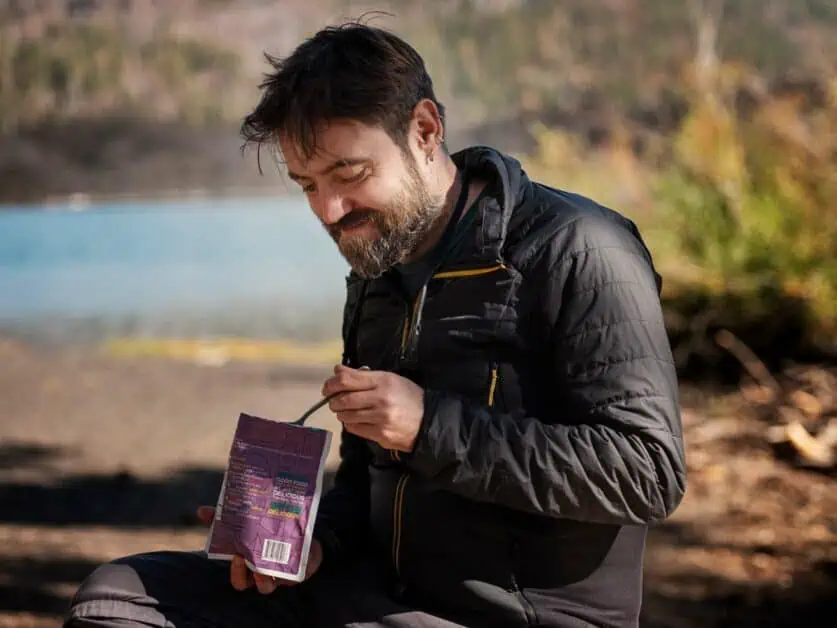
Mountain House Chicken Teriyaki with Rice
This Japanese inspired dish has a generous amount of chicken bits with long-grained rice along with peas, carrots, onion, red bell peppers, and mushrooms and are coated in an Asian-inspired sauce containing soy sauce, sake, garlic, and ginger.
Servings:
2 servings per pouch. Also available in a bulk 10 servings tin
Weight:
4.2 ounces
Rehydration Time:
9 minutes
Calories:
240 per serving, 480 per pouch
Carbohydrates:
42g per serving, 63g per pouch
Protein:
12g per serving, 24g per pouch
AlpineAire Foods Pork Jambalaya
A spicy combination of shredded pulled pork, onion, celery, spinach, carrot, red and green bell peppers, tomatoes, and onions are with rice seasoned with paprika, turmeric, garlic, Worcestershire sauce, cayenne pepper, parsley, oregano, thyme, chives, and black pepper. As you can deduce from the ingredients, this meal has a lot of flavors with a spicy kick that isn’t too hot for most people.
Servings:
1 serving per pouch
Weight:
6 ounces
Rehydration Time:
10 – 12 minutes
Calories:
310 per serving/pouch
Carbohydrates:
20g per serving/pouch
Protein:
15g per serving/pouch
AlpineAire Foods Wild Mushroom Fettuccine Alfredo
Small fusilli (spiral) pasta with champignon mushrooms, shallots, onion, and spinach in a creamy, cheesy sauce. This is a very popular dish with everyone, but the great thing is this meal is also suitable for vegetarians.
Servings:
1 serving per pouch
Weight:
5.4 ounces
Rehydration Time:
10 – 12 minutes
Calories:
630 per serving/pouch
Carbohydrates:
87g per serving/pouch
Protein:
27g per serving/pouch
Nomad Nutrition Caribbean Curry
This has organic quinoa is with yam (sweet potato), potatoes, broccoli, onions, carrots, green pepper, split peas, crushed tomatoes, and sundried tomatoes in coconut milk seasoned with curry powder, grated ginger, and cayenne pepper. Whilst this meal is very popular with meat-eaters, the great thing is that it is vegan suitable and also gluten free.
Servings:
1 serving per pouch
Weight:
4 ounces
Rehydration Time:
12 – 15 minutes
Calories:
500 per serving/pouch
Carbohydrates:
70g per serving/pouch
Protein:
11g per serving/pouch
Backpacker's Pantry Santa Fe Style Rice & Beans with Chicken
Brown rice is the basis of this meal, with small shreds of mesquite chicken, black beans, tomato, hatch green chili pepper, and sweet corn seasoned with garlic, cumin seed, and oregano. This meal is very popular as it has a lot of Tex-Mex flavor without being too hot. It has a long rehydration time, and many recommend leaving it even longer. The instructions say to stir halfway through, but it helps to break up any lumps and give it a good mix before you add the water.
Servings:
2 servings per pouch, also available in a 6-pack
Weight:
6.2 ounces
Rehydration Time:
15-20 minutes
Calories:
300 per serving, 600 per pouch
Carbohydrates:
47g per serving, 94g per pouch
Protein:
20g per serving, 40g per pouch
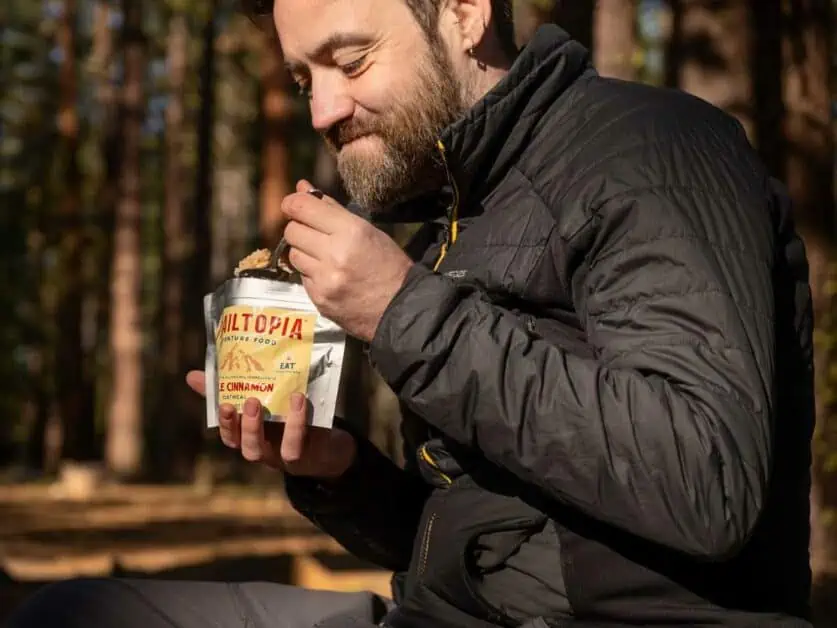
Heather's Choice Spinach Curry with Chicken and Rice
This curry has rice with tiny pieces of chicken, spinach, and onion in vegetable stock with ghee-clarified butter, ground ginger, garlic, sea salt, fenugreek, turmeric, dried jalapenos, cumin, chili powder, paprika, coriander. There are a lot of flavors, but it doesn’t taste particularly hot. It’s not quick to make, taking 20 minutes or more, but it is a generous portion with lots of protein. This meal is also gluten free.
Servings:
1 serving per pouch
Weight:
4 ounces
Rehydration Time:
20 minutes
Calories:
540 per serving/pouch
Carbohydrates:
63g per serving/pouch
Protein:
36g per serving/pouch
Good To-Go Thai Curry
Jasmine Rice with green beans, onion, broccoli, cauliflower, and peas in a spicy yellow coconut curry sauce. The curry sauce has authentic Thai flavors with coconut milk, fish sauce, garlic, lemongrass, brown sugar, tamarind, ginger, turmeric, coriander, cumin, cinnamon, Thai chilies, cardamom, yellow mustard seeds, black peppercorns, fennel seeds, cloves, kaffir lime leaf, and bay leaf. That’s a long list of seasonings, and they help to make this curry delicious. This is a very popular meal, winning the Backpacker Magazine Editors’ Choice Award in 2014. It is only pescatarian because it contains fish sauce, otherwise it would be suitable for vegetarians (we’d love to see them omit the fish sauce to make this meal fully suitable for vegetarians). It takes a while to rehydrate, but it is worth the wait.
Servings:
1 serving per pouch, also available in a 2 servings pouch.
Weight:
3.4 ounces
Rehydration Time:
20 minutes
Calories:
380 per serving/pouch
Carbohydrates:
56g per serving/pouch
Protein:
10g per serving/pouch
Soup
Soup is brilliant for warming you up and recharging your energy levels. Freeze-dried soups are light-weight, filling, and nutritionally balanced to meet the needs of a backpacker. If you don’t have a sweet tooth, you can use soup as a starter which is an easy way to increase the calorie count of your main meal. On a long hike having soup at lunchtime is a great way to fuel your body while being easy to digest.
Nomad Nutrition Ukrainian Borscht
A great vegan, protein packed option. This traditional beetroot soup has some extra ingredients to keep you fuelled when backpacking. As well as beetroot, you get potatoes, cabbage, onions, carrots, kidney beans, tomatoes, and split peas seasoned with garlic, lemon juice, black pepper, spices, and dill. It’s a really nice, thick, filling soup with a subtle kick of spices. It needs at least 15 minutes or more to rehydrate and a bit of extra water to make it more like a soup than a stew.
Servings:
1 serving per pouch
Weight:
4 ounces
Rehydration Time:
12 – 15 minutes
Calories:
470 per serving/pouch
Carbohydrates:
67g per serving/pouch
Protein:
14g per serving/pouch
Good To-Go Roasted Corn Chowder
Flakes of smoked fish (Bonito) are mixed with roasted sweet corn, potato, yam (sweet potato), carrots, shallots, leeks, and onion in milk flavored with parsley and black pepper. This is a rich soup with a strong fish taste. You might want to add a bit more water than the packet says.
Servings:
1 serving per pouch, also available in 2 serving pouch
Weight:
3.9 ounces
Rehydration Time:
15 minutes
Calories:
330 per serving/pouch
Carbohydrates:
63g per serving/pouch
Protein:
13g per serving/pouch
Patagonia Provisions Organic Black Bean Soup
This vegan safe and gluten free soup has black beans, corn, tomatoes, red bell peppers, and onion seasoned with chipotle peppers and garlic. It isn’t made in the pouch; instead, you bring the water to the boil and add the packet’s contents to the pan. If you want to save fuel, turn it off after boiling for a minute and leave it to stand.
Servings:
2 servings per pouch, also available in a 6-pack and 12-pack
Weight:
5.8 ounces
Rehydration Time:
10 minutes
Calories:
280 per serving, 570 per pouch
Carbohydrates:
54g per serving, 107g per pouch
Protein:
17g per serving, 34g per pouch
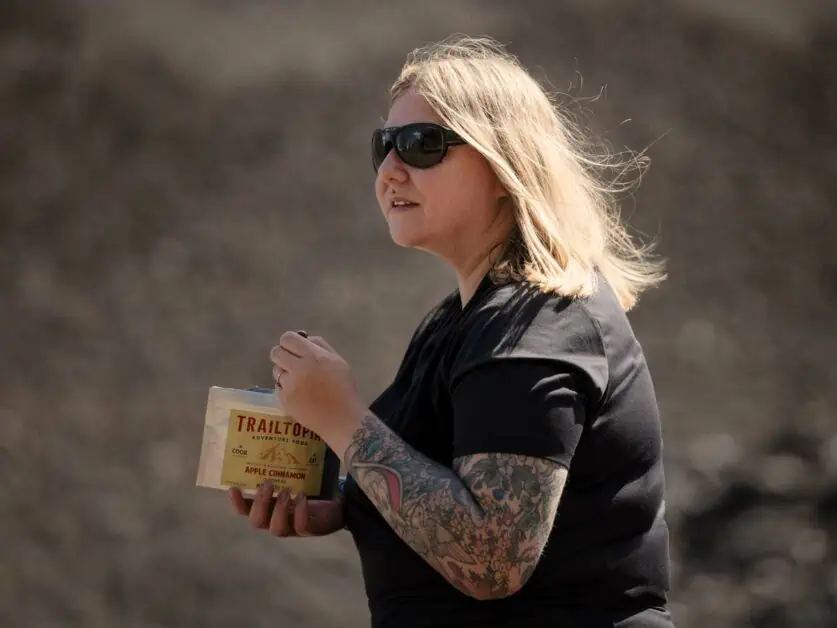
Patagonia Provisions Organic Green Lentil Soup
A great vegan option. Green lentils and bulgur wheat are the main ingredients of this soup, along with chopped onion, green and red bell peppers seasoned with garlic and spices. Like the other Patagonia soup above, this isn’t made in the pouch, but instead, you bring the water to the boil and add the packet’s contents to the pan. If you want to save fuel, turn it off after boiling for a minute and leave it to stand.
Servings:
2 servings per pouch, also available in a 6-pack and 12-pack
Weight:
5.8 ounces
Rehydration Time:
10 minutes
Calories:
210 per serving, 430 per pouch
Carbohydrates:
40g per serving, 80g per pouch
Protein:
13g per serving, 25g per pouch
Heather's Choice Vegetable Lentil Soup
This vegan and gluten free option contains chunks of carrots, potatoes, and celery join lentils, onion, garlic, and cumin in this filling soup. It needs a bit more water than the packet says to make it the consistency of soup. It is also a little on the bland side, so if you take some seasoning and some chilli flakes, you should be good. It’s also got lots of protein to fuel your hike.
Servings:
1 serving per pouch
Weight:
4 ounces
Rehydration Time:
20 minutes
Calories:
420 per serving/pouch
Carbohydrates:
74g per serving/pouch
Protein:
23g per serving/pouch
Dessert
Incorporating freeze-dried desserts with your main meal offers backpackers several benefits. First, it ensures a well-rounded intake of calories, vital after a demanding day on the trail. Desserts can provide quick-digesting carbohydrates for immediate energy replenishment. Additionally, these desserts often contain fats and proteins, further enhancing the meal’s caloric density. Moreover, enjoying a dessert can be a morale booster, offering a psychological uplift by introducing a taste of comfort and indulgence in a challenging environment. Together, the nutritional and psychological perks make freeze-dried desserts a wise addition to a backpacker’s main meal.
Peak Refuel Peach Cobbler
Chunks of pound cake, nuggets of sweet granola, and generous slices of peach in cream make up this dessert. This rehydrates very well, and it’s a great way to replenish the calories you have been burning on the trail.
Servings:
2 servings per pouch
Weight:
4.93 ounces
Rehydration Time:
10 minutes
Calories:
340 per serving, 670 per pouch
Carbohydrates:
50g per serving, 100g per pouch
Protein:
6g per serving, 11g per pouch
Peak Refuel Mountain Berry Cobbler
Like the peach cobbler, this has chunks of pound cake, nuggets of sweet granola, and cream, but you get strawberries, blueberries, raspberries, and a sprinkling of cinnamon. You can make it with hot or cold water; some people like to eat it after 5 minutes to have extra crunch.
Servings:
2 servings per pouch
Weight:
4.93 ounces
Rehydration Time:
10 minutes
Calories:
300 per serving, 600 per pouch
Carbohydrates:
47g per serving, 94g per pouch
Protein:
5g per serving, 10g per pouch
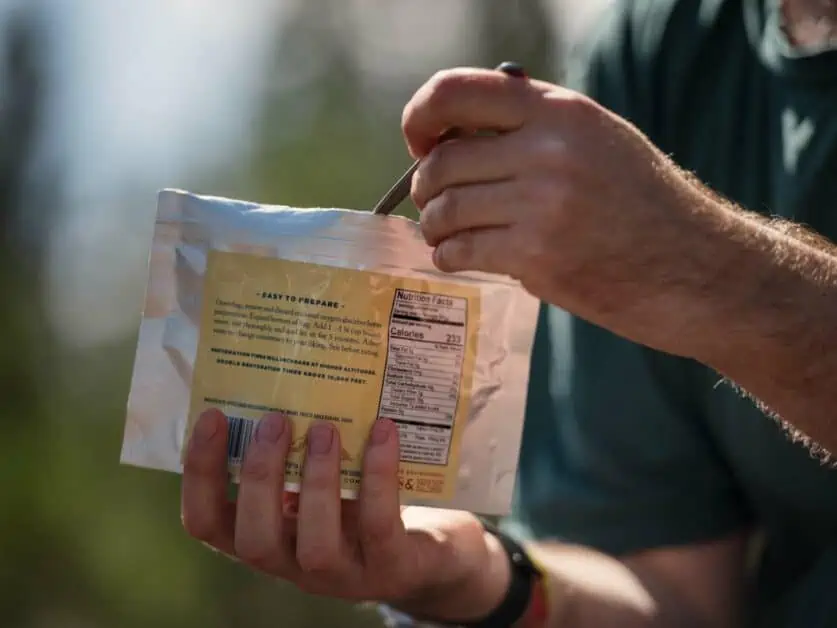
AlpineAire Foods Cinnamon Apple Crisp
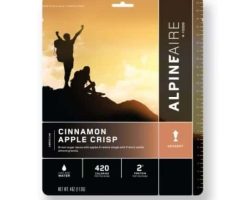
This dessert has diced apples, raisins, French vanilla almond granola, honey, and more almonds in a brown sugar sauce with ground cinnamon, orange, and more vanilla. It’s very sweet and sticky, with the granola providing a crunchy contrast to the soft apples.
Servings:
1 serving per pouch
Weight:
4 ounces
Rehydration Time:
10 – 12 minutes
Calories:
440 per serving/pouch
Carbohydrates:
97g per serving/pouch
Protein:
3g per serving/pouch
AlpineAire Foods Chocolate Mudslide
A rich, creamy chocolate pudding that’s made with cold water. Once it’s ready, sprinkle on the chocolate cookie-crumb crust and crunchy toffee peanuts. I don’t like vanilla, but I love chocolate, so this is much more my kind of dessert than the option above.
Servings:
1 serving per pouch
Weight:
5 ounces
Rehydration Time:
8 – 10 minutes
Calories:
290 per serving/pouch
Carbohydrates:
45g per serving/pouch
Protein:
9g per serving/pouch
Backpacker's Pantry Blueberry Peach Crisp
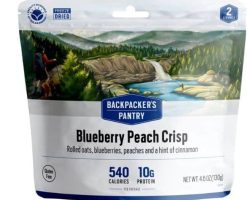
Granola, coconut, almonds, rolled oats, blueberries, and peaches are coated in butter, brown sugar, lemon juice, and cinnamon.
Servings:
2 servings per pouch
Weight:
4.6 ounces
Rehydration Time:
7 minutes
Calories:
290 per serving/pouch
Carbohydrates:
45g per serving/pouch
Protein:
9g per serving/pouch
Trailtopia Cheesecake Dessert
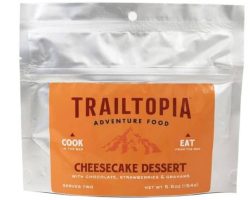
Creamy cheesecake filling with chocolate chips and freeze-dried strawberries make up this version of the classic dessert. It’s made with cold water, and when it’s ready, there’s a little packet of graham crackers to sprinkle on top to add a bit of crunchiness.
Servings:
2 servings per pouch
Weight:
5.5 ounces
Rehydration Time:
10 minutes
Calories:
320 per serving, 640 per pouch
Carbohydrates:
58g per serving, 116 per pouch
Protein:
6g per serving, 12g per pouch
Snacks
Backpackers should snack while hiking to maintain energy levels and stamina. Consistent snacking provides a steady supply of calories, preventing energy dips and fatigue. The body can only process a few hundred calories per hour while exercising. This amount will keep energy levels constant and won’t overload the stomach. Consuming too many calories at one time diverts blood away from working muscles in favor of digestion. Snacking also helps in replenishing glycogen stores, which are crucial for muscle function. Snacking can stabilize blood sugar levels, ensuring both physical and mental sharpness during strenuous activity. Moreover, regular intake of small amounts of food can prevent excessive hunger, aiding in better digestion and overall well-being on the trail.
Peak Refuel Chocolate Fudge Brownie Bites
These freeze-dried chunks of chocolate fudge brownies are perfect for snacking on if you are craving chocolate on the trail. They are bite-sized, and the freeze-drying has made them crunchy and hard, so they won’t disintegrate in your rucksack. They are often compared to the outside edges of a regular brownie.
Servings:
2 servings per pouch
Weight:
4.6 ounces
Rehydration Time:
Ready to eat
Calories:
300 per serving, 610per pouch
Carbohydrates:
51g per serving, 102g per pouch
Protein:
3g per serving, 7g per pouch
Peak Refuel Peanut Butter Chocolate Chip Cookie Bites
Like the chocolate fudge brownies above, these are small bite-sized cookies with peanut butter and chocolate chips. When I say bite-sized, you can get 4 or 5 in your mouth! Being freeze-dried, they are firm and don’t crumble, but that does make them a bit crunchy.
Servings:
2 servings per pouch
Weight:
4.72 ounces
Rehydration Time:
Ready to eat
Calories:
320 per serving, 640per pouch
Carbohydrates:
47g per serving, 95g per pouch
Protein:
5g per serving, 11g per pouch
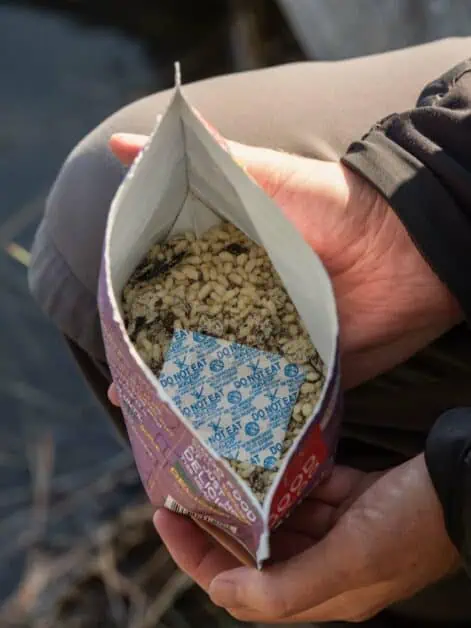
Heather's Choice Packaroons
Packaroons are a very popular snack for hiking. The name combines ‘backpack’ and ‘macaroons’ because these are small dehydrated coconut cookies. There are lots of flavors to choose from, including Lemon Lavender, Orange Vanilla, Mint Chocolate and Cherry Almond, Blueberry Almond, Black Espresso, Snickerdoodle, and plain Sweet Coconut. They provide a great hit of sweetness to keep you going no matter how long the hike is.
Servings:
1 serving per pouch
Weight:
1 ounces
Rehydration Time:
Ready to eat
Calories:
170 per serving/pouch
Carbohydrates:
13g per serving/pouch
Protein:
2g per serving/pouch
Mountain House Vanilla Ice Cream Sandwich
Freeze-dried vanilla ice cream sandwiched between two rectangular slices of chocolate cookie. It’s a slightly strange texture as the ‘ice cream’ is hard, but if you want something sweet, this will hit the spot. It’s not robust, so if it’s at the bottom of your backpack, you may only have crumbs when you open the packet.
Servings:
1 bar per pouch
Weight:
2.1 ounces
Rehydration Time:
Ready to eat
Calories:
140 per serving/pouch
Carbohydrates:
23g per serving/pouch
Protein:
2g per serving/pouch
Mountain House Mint Chocolate Chip Ice Cream Sandwich
Freeze-dried mint chocolate chip ice cream is sandwiched between two rectangular slices of chocolate cookie. As with the vanilla version above, it has a slightly strange texture as the ‘ice cream’ is hard, but if you want something sweet, this will hit the spot. It’s not robust, so if it’s at the bottom of your backpack, you may only have crumbs when you open the packet. I’m not too fond of vanilla, but I love chocolate and mint, so I prefer this version.
Servings:
1 bar per pouch
Weight:
2.1 ounces
Rehydration Time:
Ready to eat
Calories:
140 per serving/pouch
Carbohydrates:
23g per serving/pouch
Protein:
2g per serving/pouch
Backpacker's Pantry Astronaut Neapolitan Ice Cream Sandwich
Astronaut ice cream sounds more exciting than freeze-dried ice cream, but it’s the same thing. Three slabs of ice cream in the traditional strawberry, vanilla, and chocolate flavors are placed between two slices of chocolate cookie. The texture of the ice cream is entirely different, firm, and a bit squidgy, but the taste is just the same. It’s easily broken up into bits, so avoid leaving it in the bottom of your bag.
Servings:
1 serving per pouch
Weight:
5 ounces
Rehydration Time:
Ready to eat.
Calories:
130 per serving/pouch
Carbohydrates:
21g per serving/pouch
Protein:
2g per serving/pouch
Backpacker's Pantry Mint Chocolate Chip Ice Cream
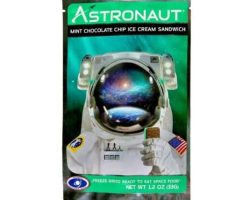
Green, mint-flavored ice cream with chocolate chips is sandwiched between two slices of chocolate cookies. As mentioned above, the texture of the ice cream is obviously completely different, firm but a bit squidgy, but the taste is just the same. It’s easily broken up into bits, so not one to leave in the bottom of your bag.
Servings:
1 serving per pouch
Weight:
1.2 ounces
Rehydration Time:
Ready to eat
Calories:
130 per serving/pouch
Carbohydrates:
15g per serving/pouch
Protein:
2g per serving/pouch
Vegetarian and Vegan
The good news is that there is a lot of choice available for vegetarian and vegan hikers looking for freeze-dried meals. Ingredients such as potatoes, beans, and carrots that usually add a lot of weight to your pack are made lightweight by the freeze-drying process. So you can get the nutrition you need to keep walking.
Breakfast
A lot of freeze-dried breakfasts are suitable for vegetarians and vegans already, but the great news is that some have been specifically designed for those who have chosen not to eat meat. Making it easier, and safer to know that you’re getting something that fits your needs.
Backpacker's Pantry Summit Breakfast Scramble
Vegetarian. Spicy eggs and potato with red beans, cheddar cheese, and bell peppers are seasoned with cayenne pepper, black pepper, chili, and smoked paprika. It can be a bit watery, so it might be worth putting less water in and then checking it after about 10 minutes.
Servings:
1 serving per pouch, 6 pack available
Weight:
2.1 ounces
Rehydration Time:
15 minutes
Calories:
230 per serving/pouch
Carbohydrates:
24g per serving/pouch
Protein:
17g per serving/pouch

Mountain House Veggie Chorizo Breakfast Scramble
Vegetarian. Scrambled eggs are combined with potato, onion, green bell pepper, and non-meat chorizo, seasoned with garlic, paprika, and black pepper. It has a bit of a kick, and meat-eaters alike love the vegetarian chorizo.
Servings:
2 serving per pouch, 6 pack available
Weight:
4 ounces
Rehydration Time:
15 minutes
Calories:
290 per serving, 580 per pouch
Carbohydrates:
21g per serving, 42g per pouch
Protein:
14g per serving, 28g per pouch
Good To-Go Breakfast Hash
Vegetarian. This isn’t a traditional breakfast hash. Instead, small pieces of butternut squash, feta cheese, carrot, onion, a bit of potato, and spinach are flavored with garlic.
Servings:
1 serving per pouch,
Weight:
3.4 ounces
Rehydration Time:
15 minutes
Calories:
360 per serving/pouch
Carbohydrates:
59g per serving/pouch
Protein:
11g per serving/pouch
Nomad Nutrition Cali Breakfast Bowl
(Vegan/plant based) Quinoa, tofu, chickpeas, and yam (sweet potatoes) are added to potatoes, onions, red pepper, Kalamata olives, kale, and diced tomatoes and seasoned with garlic, black pepper, and spices. This could actually be eaten as a meal as well as breakfast and it is packed full of vegetables and carbohydrates. Unless you like crunchy chickpeas, it does need at least 15 minutes or more of rehydration time.
Servings:
1 serving per pouch, also available in 10 serving bag
Weight:
4 ounces
Rehydration Time:
10 – 15 minutes
Calories:
470 per serving/pouch
Carbohydrates:
68g per serving/pouch
Protein:
15g per serving/pouch
Main Meal
Your main meal when you are backpacking must give you the energy and nutrition you need to refuel and repair your muscles. Freeze-dried vegan and vegetarian meals are designed to deliver plenty of protein without adding to the weight of your backpack.
Peak Refuel Butternut Dal Bhat
Vegan. This has red lentils, chickpeas, long-grain rice, and butternut squash in a spicy coconut sauce seasoned with garlic, chili powder, cilantro (coriander), and soy sauce. It’s spicy without being hot and full of flavor.
Servings:
2 servings per pouch. Also available in bulk 10 servings tin
Weight:
5.85 ounces
Rehydration Time:
10 minutes
Calories:
430 per serving, 870 per pouch
Carbohydrates:
52g per serving, 105g per pouch
Protein:
12g per serving, 23g per pouch
AlpineAire Foods Wild Mushroom Fettuccine Alfredo
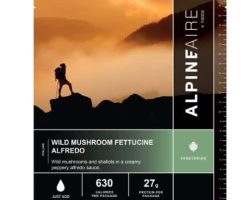
Vegetarian. Small fusilli (spiral) pasta with champignon mushrooms, shallots, onion, and spinach in a creamy, cheesy sauce. This meal is suitable for vegetarians, but it is very popular with everyone.
Servings:
1 serving per pouch
Weight:
5.4 ounces
Rehydration Time:
10 – 12 minutes
Calories:
630 per serving/pouch
Carbohydrates:
87g per serving/pouch
Protein:
27g per serving/pouch
Backpacker's Pantry Pad Thai
Vegan/plant based. Short strands of rice noodles with red bell pepper and green onions in a spicy Sriracha lime sauce with peanut butter and dry roasted peanuts added at the end. The sauce is made from tomatoes, white vinegar, garlic, cilantro, crushed red chili pepper, sriracha powder, and jalapeno chili pepper. This meal divides people, with many loving it because of its strong, spicy flavor and others finding it overpowering. We love it!
Servings:
2 servings per pouch
Weight:
6.2 ounces
Rehydration Time:
15-20 minutes
Calories:
370 per serving, 730 per pouch
Carbohydrates:
53g per serving, 105g per pouch
Protein:
12g per serving, 23g per pouch
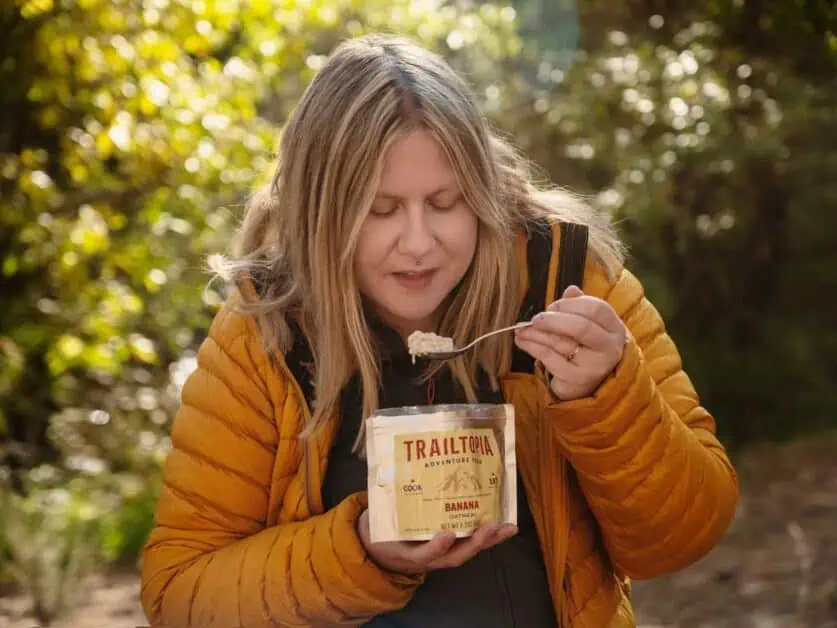
Heather's Choice African Peanut Stew
Vegan/plant based. This stew has diced tomatoes, sweet potatoes, peanut butter, Swiss chard, and onion in a vegetable stock spiced with garlic, ginger, and yellow curry powder. Most people enjoyed the mild spice and found it filling. It also used to have rice in the pouch, but that has been removed.
Servings:
1 serving per pouch
Weight:
4 ounces
Rehydration Time:
20 minutes
Calories:
480 per serving/pouch
Carbohydrates:
75g per serving/pouch
Protein:
10g per serving/pouch
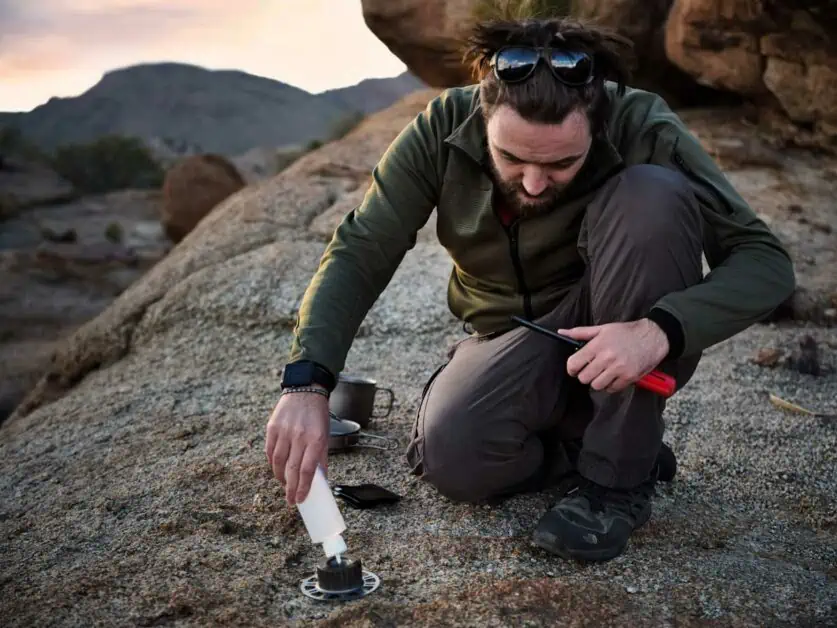
Essentials For a Backpacker’s Camp Kitchen
Stove System
If all you plan to do on your backpacking trip is boil water, you can get lightweight stove systems designed to do just that. We particularly love the Jetboil System.
Ultralight Stove
You may wish to do a little more cooking than just boiling water, in which case you will need a stove. We are more a fan of the MSR LowDown Remote Stove Adaptor as it feels more stable for cooking. You may want to look at grilling as well to add some variety to the mix, especially if you’re backpacking for a while. There are some great ultralightweight grills available now, be sure to check out our guide to the best backpacking grills.
Cookpots and pans
Most freeze-dried meals can be made in the pouch they come in, but not all. You need a lightweight cooking pan if you want to do more cooking than boiling water. You can get sets of pans that fit neatly inside each other to reduce the space they take up in your pack. We recommend GSI Outdoors Glacier Vase Camper Cookset.
Utensils
Obviously, you will need something to eat with. Sporks are popular, but a knife also comes in useful. To reach the bottom of most freeze-dried meals, you need something with a longer handle than usual. We recommend the OUTXE Titanium Long Handle Spork.
Cup
You will need a cup, not just to drink out of but also to measure the amount of water required to make your meal. For recipes, a cup is eight fluid ounces, but it is essential to check that your camping cup does hold that quantity. If the cup you are taking camping holds a different amount, it might be worth putting some tape around the outside of the cup to mark the correct level. Check the instructions on the food packets you are taking to see if it is worth marking four fluid ounces if half a cup is required. We recommend this one.
Clean Up
Practising Leave No Trace means as backpackers, we need to leave the wilderness as pristine as we find it, so all your trash must be carried out with you. One of the advantages of freeze-dried meals is that they can usually be eaten directly out of the packet, so you don’t have any plates to clean. Freeze-dried meals often come in pouches that seal shut, so they can be handy for containing your trash before you put it in your backpack. If you plan to do more cooking than boiling water, you will also need to ensure you have the necessary equipment to clean your pots, pans, and plates. Any dirty water you create must be disposed of in a hole at least 200 feet from any water source. If you want to use some kind of soap, you must ensure it is biodegradable. We prefer to use Dr. Bronner’s soap for this reason, which you can either buy in smaller bottles or buy a bigger bottle and dispense yourself into a smaller bottle, which often works out better value for money. It also doubles as a great wash for your body too.
Enjoy Your Freeze Dried Meals
Freeze-dried food has revolutionized the backpacking experience. Making meals lightweight and portable while at the same time preserving flavors and nutrients, it provides backpackers with a convenient and efficient meal solution. As well as cutting weight from our packs, many freeze-dried meals today are tasty and nutritious, with so many options that there is something to suit all tastes. For any backpacker planning to hike deep into the backcountry without the burden of heavy rations, freeze-dried meals are a great option, merging the best of convenience and sustenance for the trail ahead.
Disclaimer: This article contains Affiliate Links. You won’t pay any more for buying through these links, but we may receive a commission from any purchases made through them. As an Amazon Associate, I earn from qualifying purchases. If you choose to support us by buying through our links, we thank you as it helps us to continue providing the resources we do to help you enjoy the outdoors more!






































